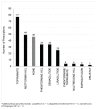Impact of a Community-Based Weight Management Program in a North Carolina Health Care System
- PMID: 36888674
- PMCID: PMC10622008
- DOI: 10.22454/FamMed.2023.603918
Impact of a Community-Based Weight Management Program in a North Carolina Health Care System
Abstract
Background and objectives: Current strategies for obesity management in primary care leave many patients inadequately treated or unable to access treatment entirely. We aimed to evaluate a comprehensive, primary care clinic-based weight management program's clinical effectiveness in a community practice setting. Methods: This was an 18-month pre/postintervention study. We collected demographic and anthropometric data on patients enrolled in a primary care-based weight management program. The primary outcomes were percent weight loss postintervention and the proportion of patients who achieved a clinically significant total body weight loss (TBWL) of 5% or greater. Results: Our program served 550 patients over 1,952 visits from March 2019 through October 2020. A total of 209 patients had adequate program exposure, defined as four or more completed visits. Among these, all received targeted lifestyle counseling and 78% received antiobesity medication. Patients who attended at least four visits had an average TBWL of 5.7% compared to an average gain of 1.5% total body weight for those with only one visit. Fifty-three percent of patients (n=111) achieved greater than 5% TBWL, and 20% (n=43) achieved greater than 10% TBWL.
Conclusion: We demonstrated that a community-based weight management program delivered by obesity medicine-trained primary care providers effectively produces clinically significant weight loss. Future work will include wider implementation of this model to increase patient access to evidence-based obesity treatments in their communities.
Figures
References
-
- Warren M, Beck S, Lieberman D. The state of obesity: better policies for a healthier America. Trust for America's Health. 2021. https://www.tfah.org/wp-content/uploads/2021/09/2021ObesityReport_Fnl.pdf https://www.tfah.org/wp-content/uploads/2021/09/2021ObesityReport_Fnl.pdf
-
- Adult obesity prevalence maps. Centers for Disease Control and Prevention. 2021. https://www.cdc.gov/obesity/data/prevalence-maps.html https://www.cdc.gov/obesity/data/prevalence-maps.html
-
- Ashman J J, Rui P, Okeyode T. Characteristics of office-based physician visits. NCHS Data Brief. 2016;(331):1–8. - PubMed




